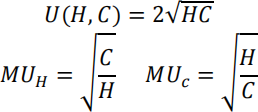ECON 281 - B05: Intermediate Microeconomic Theory I Winter 2024 Assignment 1
Hello, dear friend, you can consult us at any time if you have any questions, add WeChat: daixieit
ECON 281 - B05: Intermediate Microeconomic Theory I
Winter 2024
Assignment 1
Due: 2024-01-26 In Class (by 3:50PM)
Part A - Short Answer
Please use graphs, formulas, or concise sentences to answer the questions below. When using graphs, please clearly label the axes, lines (or curves) and necessary points.
Full marks will be awarded if your answers are justified. (40 marks, 5 marks each)
1. Suppose the market of coffee beans starts at equilibrium at time 0, the demand for coffee beans increases at time 1, what will happen to the equilibrium price and quantity? If the supply of coffee beans increases at time 2, what will happen to the equilibrium price and quantity at time 2, compared to the equilibrium at time 0? Please illustrate your results using graphs.
2. When the price of the latest iPhone increased by 10%, its sales decreased by 8%. Calculate the price elasticity of demand. What should the company do to increase its revenue, and why?
3. If Mary prefers apple over banana, and prefers banana over cherry, what can you conclude about Mary’s preference between apple and cherry, and why?
4. When Andy makes egg sandwiches to eat, he uses exactly 1 egg (E) and 2 slices of bread (B) for each sandwich. What type of utility function is it? Suppose every sandwich Andy eats gives him a utility of 2, write down Andy’s utility function and graph the indifference curves corresponding to utility levels of 2, 4, and 18.
5. When the price of product A is increased by 10%, the sales of product B decrease by 5%. Calculate this elasticity. What type of elasticity is this, and what can you conclude about the relationship between product A and product B?
6. Anne likes both apples (A) and bananas (B), and she is always willing to exchange 1 apple for 2 bananas. What type of utility function is it? Suppose 2 apples and 2 bananas give Anne a utility of 6, write down Anne’s utility function and graph indifference curves corresponding to utility levels of 6, 12, and 18.
7. What are positive and normative analyses? Give one example of each analysis regarding a tax reduction from the provincial government.
8. When Tim Hortons increased the price of its wraps by 8%, the sales of its sandwiches increased by 2%. Calculate this elasticity. What is the consumers'view of the relationship between Tim Hortons’ wraps and sandwiches?
Part B - Long Answer
Please show all the steps to your solution. When using graphs, please clearly label the axes, lines (or curves) and necessary points.
Full marks will be awarded if your answers are justified. (60 marks, 30 marks each)
1. The following equations show the supply and demand for burgers:

(1) Calculate the equilibrium price and quantity.
(2) Due to a newly introduced provincial tax, an extra $2.5 is charged by the suppliers for every unit of goods it produced (hint: the supply curve can be written as P = 7.5 + 0.5Qs , the new supply function is P = 7.5 + 0.5Qs + 2.5). Calculate new supply and new equilibrium price and quantity.
(3) Plot the change from (1) to (2) in one graph.
(4) Calculate the elasticity shown by the above change (hint: start by thinking what is the percentage change in quantity/price from the old equilibrium to the new equilibrium). Interpret the calculated elasticity. Based on your calculation, is the demand curve elastic, inelastic or unitary elastic?
2. Suppose Joe’s utility and marginal utility functions of hamburger (H) and Coca-Cola (C) are:

(1) What is the law of diminishing marginal utility? Show it using 1 and 2 hamburgers.
(2) With hamburger on the horizontal axis, graph the indifference curve associated with U = 6 and mark at least 3 points along the indifference curve.
(3) Calculate the Marginal Rate Substitution (MRS). What is diminishing MRS? Give an example using three points from your graph above.
(4) Does Joe’s preference display the pattern of “averages are preferred to extremes”? Use your graph in (2) to support your conclusion.
2024-01-27